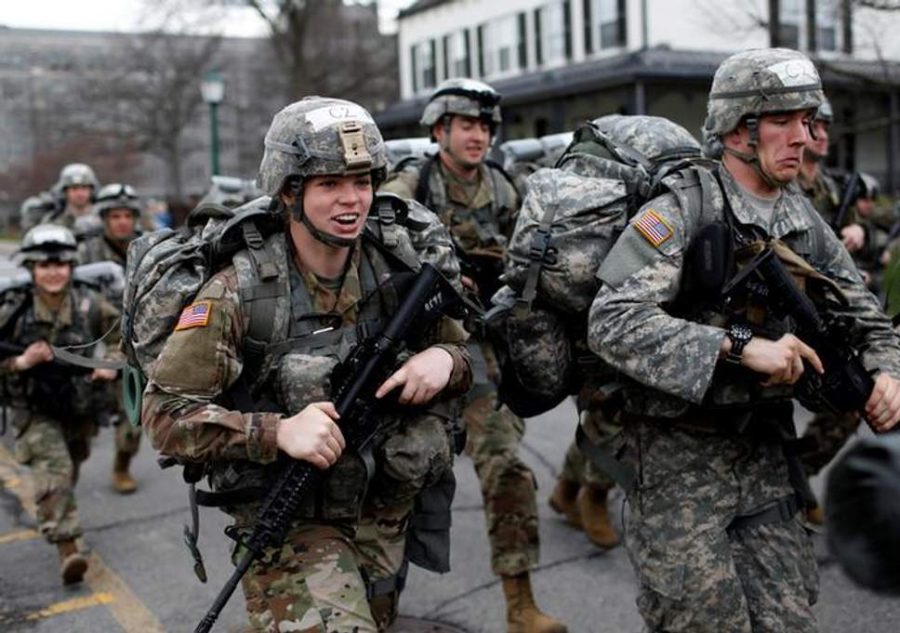The End of the All-Male Draft?
April 2, 2019
On February 25th, Judge Gray H. Miller of the Federal District Court in the Southern District of Texas ruled that the all-male draft was unconstitutional, stating that “While historical restrictions on women in the military may have justified past discrimination, men and women are now ‘similarly situated for purposes of a draft or registration for a draft.’” While women have been allowed to serve as permanent members of the U.S. military since 1948, when Congress passed the Women’s Armed Services Integration Act, and the Department of Defense opened all combat-related roles to women in 2016, currently, women would not be subject to the draft in wartime.
The history of the draft itself in the United States is a contentious one; the first national military draft in the United States occurred during the Civil War, when President Abraham Lincoln signed into law the Draft Act of 1863, which instituted a draft pool of all male citizens and would-be citizens between the ages of twenty and forty-five. However, this system in no way affected all potential draftees equally; one could legally exempt themselves from the draft by hiring a substitute to take their place or paying $300. Perhaps naturally, this draft led to ire and dismay from many; in July of 1863, particularly violent draft riots broke out in New York City, riots which eventually led to the deaths of hundreds as white workers attacked government buildings and lynched and destroyed the businesses and homes of African-American residents. In the end, however, the majority of soldiers who served in the Union Army were volunteers, not drafted citizens. A draft was again used in World War I after Congress passed the Selective Service Act of 1917; this time, however, a majority of the American Expeditionary Forces—the American army which fought on the Western Front during World War I—was drafted, and public coverage of the draft was largely positive. The first peacetime draft in American history came with the outbreak of World War II in Europe; in 1940, the Selective Training and Service Act of 1940 was signed into law, which instituted a draft lottery.
Perhaps the most memorable and contentious use of the draft in recent American history, however, was during the Vietnam War. A majority of those drafted were lower-income with few connections, a phenomenon derided in popular culture through songs like rock band Creedence Clearwater Revival’s “Fortunate Son.” Resistance to the draft was active, with some seeking legal deferments, some burning draft cards, and some fleeing to other nations.
Today, the United States’s military is all-volunteer. However, the federal government reserves the right to reinstitute the draft when necessary; as such, all males between the ages of 18-25 who are citizens or immigrants residing in the United States must register with the Selective Service, which would run the draft in the case that it is reinstituted. Those who fail to register are not eligible for federal financial aid, federal job training, or federal jobs and may also be prosecuted for their failure to register.
Judge Miller’s ruling came after a lawsuit brought forward by the National Coalition for Men, a group which advocates for the rights of men and conjectured that an all-male draft violates the 14th Amendment, which guarantees equal protection under the law. In his ruling, Miller stated that while an all-male draft was justified in the 1980s, when the Supreme Court ruled in favor of its legality and women were still excluded from many combat roles, since women are now allowed to serve in all combat capacities, there is no legal reason for them to be excluded from the draft. Though Miller is a federal judge, his ruling in no way guarantees that the federal government will begin to require women to register for the draft; it is simply a declaration in favor of doing so. However, currently, a federal commission—the National Commission on Military, National, and Public Service—is studying the current draft system and weighing the prospect of drafting women, so Miller’s ruling may be taken into account in that context.
While many elected officials in the federal government are opposed to the idea of potentially drafting women into the military—Senator Ted Cruz famously stated in 2016 that “”The idea that we should forcibly conscript young girls into combat, to my mind makes little [to] no sense”—a fair amount of students at THS stand by the belief that potentially drafting men as well as women would only be fair.
“If we’re allowing women through the same training if they want to join the military, I don’t see too much fault in allowing all Americans who are physically qualified to register into the draft regardless of gender,” stated Grace Yin (’20).
Ethan Park (’20) agreed: “Men are, on average, stronger than women, and I’d argue that accounts for a lot in a soldier’s life, but on average doesn’t mean all. If a woman is capable, then she should be drafted, and the same goes for men. I do realize that a draft is meant to be non-discriminatory in terms of who it chooses, but there are two things to be kept in mind with that: one, a draft in this mechanical era means nothing other than its symbolism, and two, if we were to send out people, those people should be capable of fighting regardless of their sex.”
While the future of the draft is yet to be seen, it is far past time for equality to be achieved in all realms of American life, from the workplace to the home to the military.

















































































































































